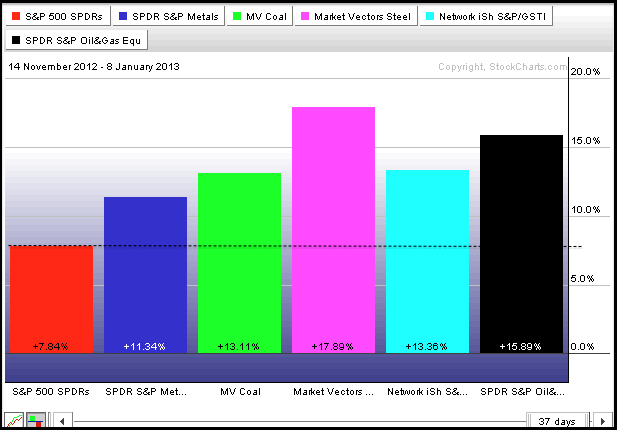Stocks extended their corrective period on Tuesday as the major index ETFs finished with small losses. Note that stocks surged on 31-Dec and 2-Jan as the major index ETFs forged big gaps. Stocks were overbought at this stage and have pretty much consolidated the last few days. The ability to hold these gains and consolidate is positive. Some industry group ETFs were hit hard on Tuesday with the Coal Vectors ETF (KOL), Metals & Mining SPDR (XME), Steel ETF (SLX), Networking iShares (IGN) and Oil & Gas Equipment/Services SPDR (XES) all falling over 1%. These ETFs were also some of the best performers since mid November and a short-term breather is justified.



**************************************************************************

**************************************************************************

**************************************************************************

**************************************************************************

**************************************************************************
Key Reports and Events:
Wed - Jan 09 - 07:00 - MBA Mortgage Index
Wed - Jan 09 - 10:30 – Oil Inventories
Thu - Jan 10 - 08:30 - Jobless Claims
Thu - Jan 10 - 10:30 - Natural Gas Inventories
Charts of Interest: Tuesday and Thursday
This commentary and charts-of-interest are designed to stimulate thinking. This analysis is
not a recommendation to buy, sell, hold or sell short any security (stock ETF or otherwise).
We all need to think for ourselves when it comes to trading our own accounts. First, it is
the only way to really learn. Second, we are the only ones responsible for our decisions.
Think of these charts as food for further analysis. Before making a trade, it is important
to have a plan. Plan the trade and trade the plan. Among other things, this includes setting
a trigger level, a target area and a stop-loss level. It is also important to plan for three
possible price movements: advance, decline or sideways. Have a plan for all three scenarios
BEFORE making the trade. Consider possible holding times. And finally, look at overall market
conditions and sector/industry performance.

About the author:
Arthur Hill, CMT, is the Chief Technical Strategist at TrendInvestorPro.com. Focusing predominantly on US equities and ETFs, his systematic approach of identifying trend, finding signals within the trend, and setting key price levels has made him an esteemed market technician. Arthur has written articles for numerous financial publications including Barrons and Stocks & Commodities Magazine. In addition to his Chartered Market Technician (CMT) designation, he holds an MBA from the Cass Business School at City University in London.
Learn More

